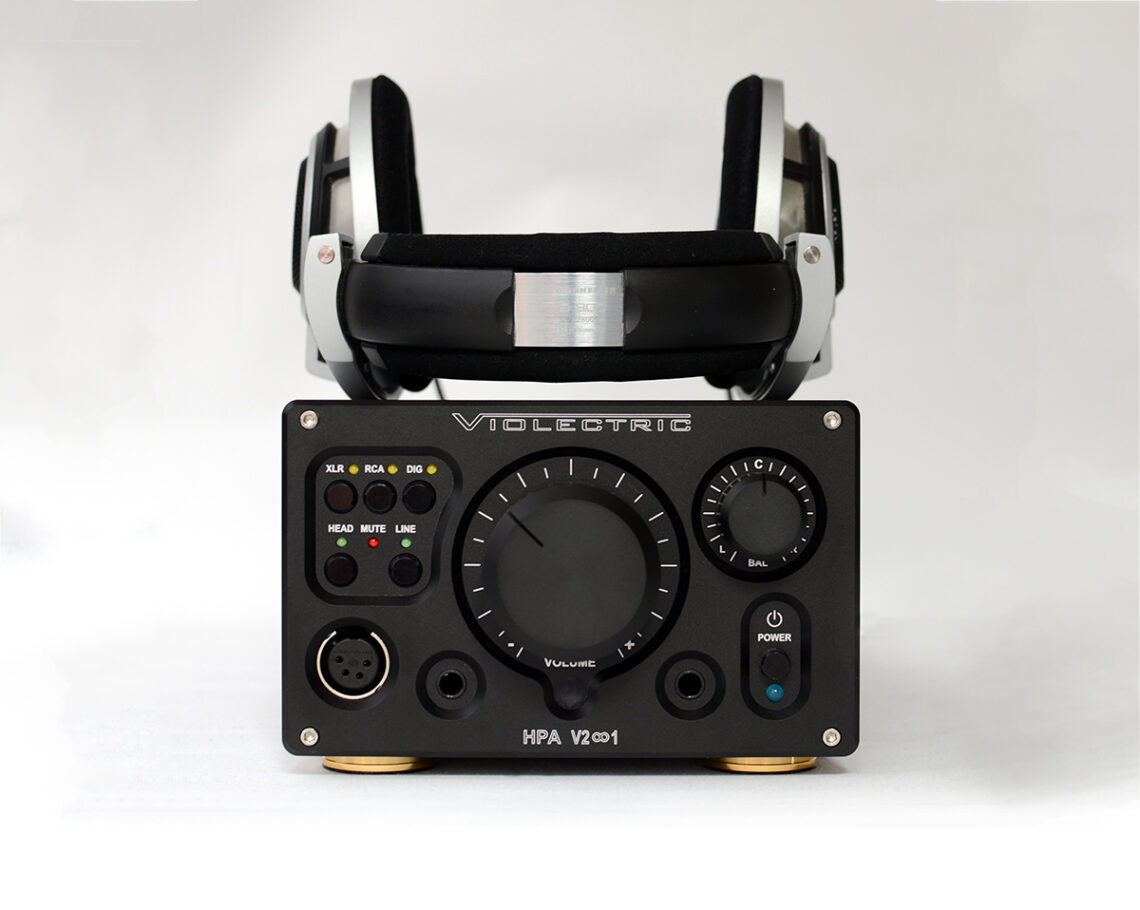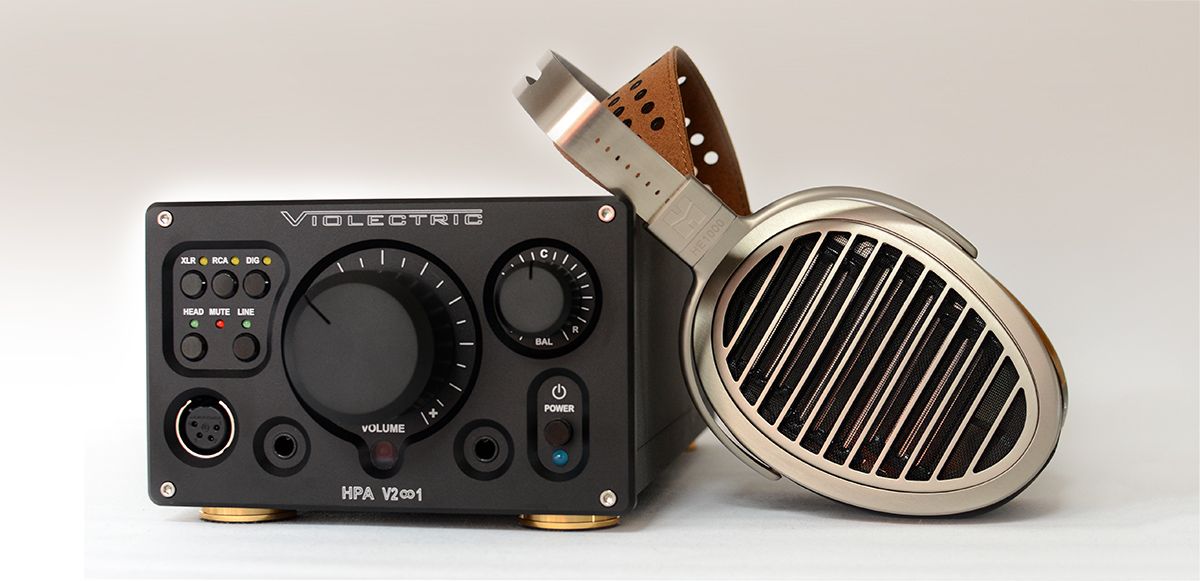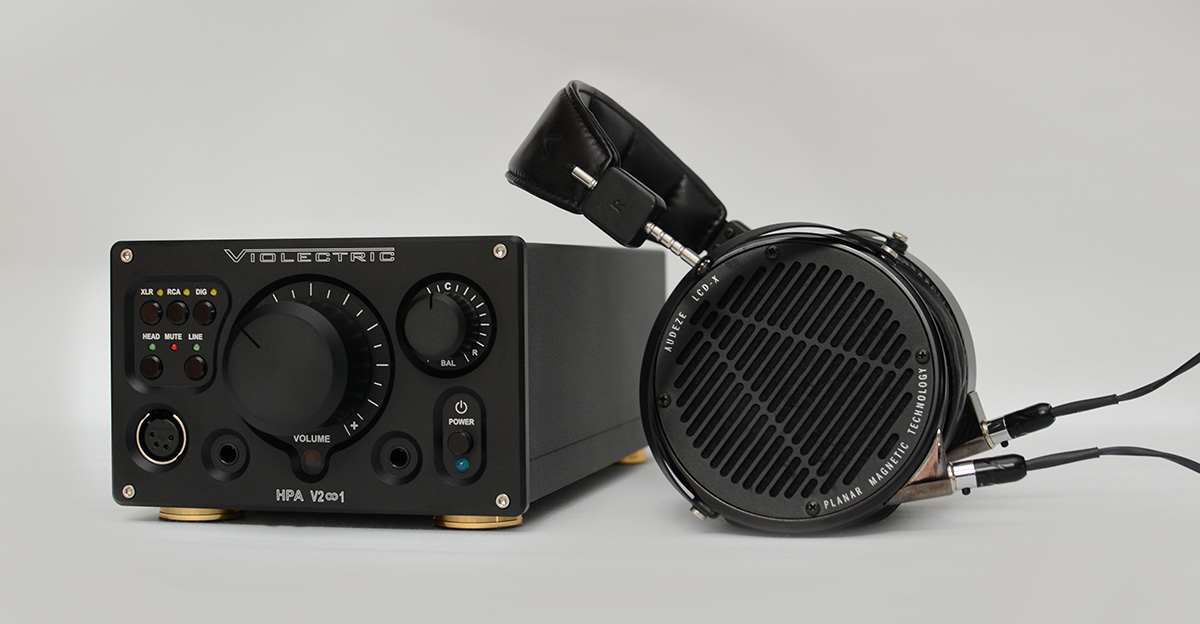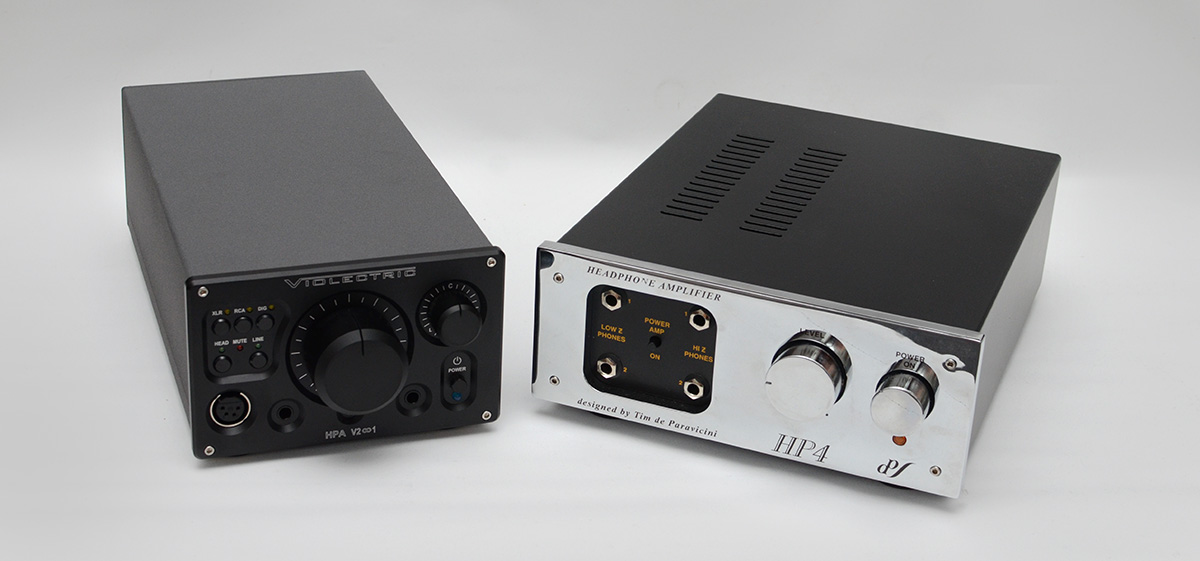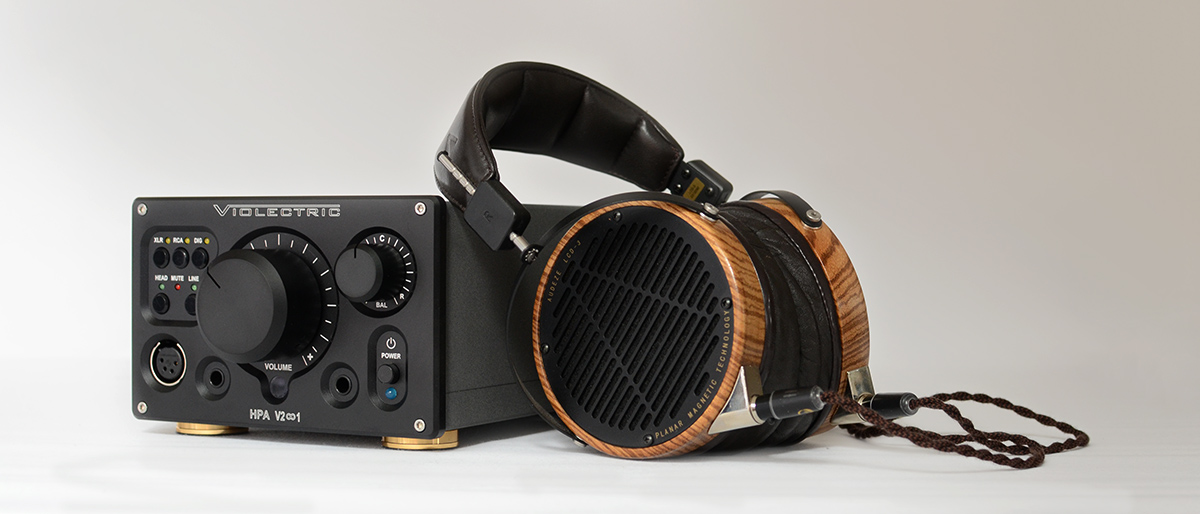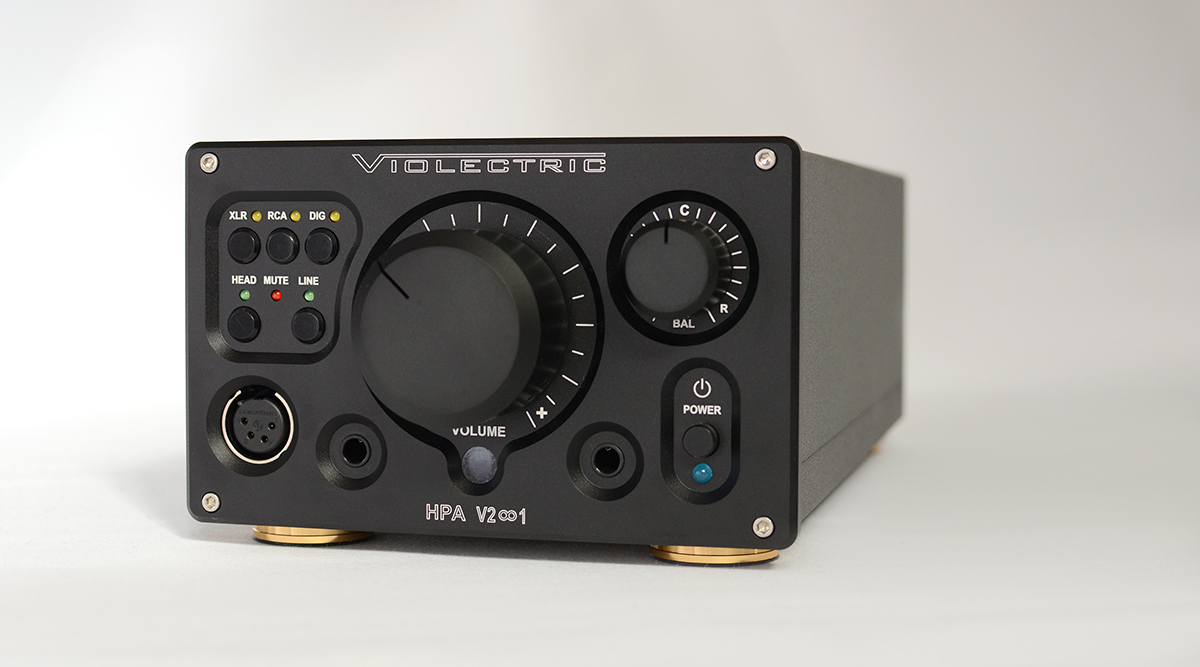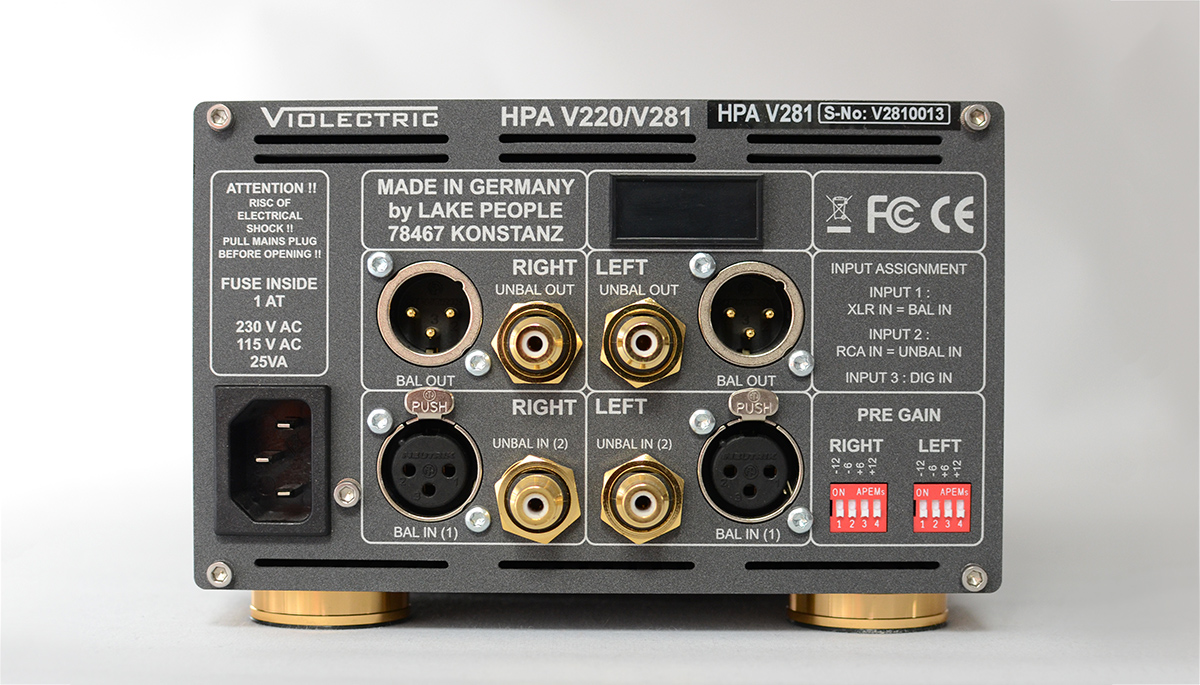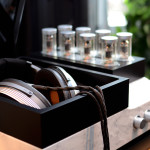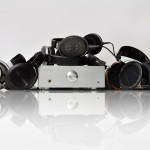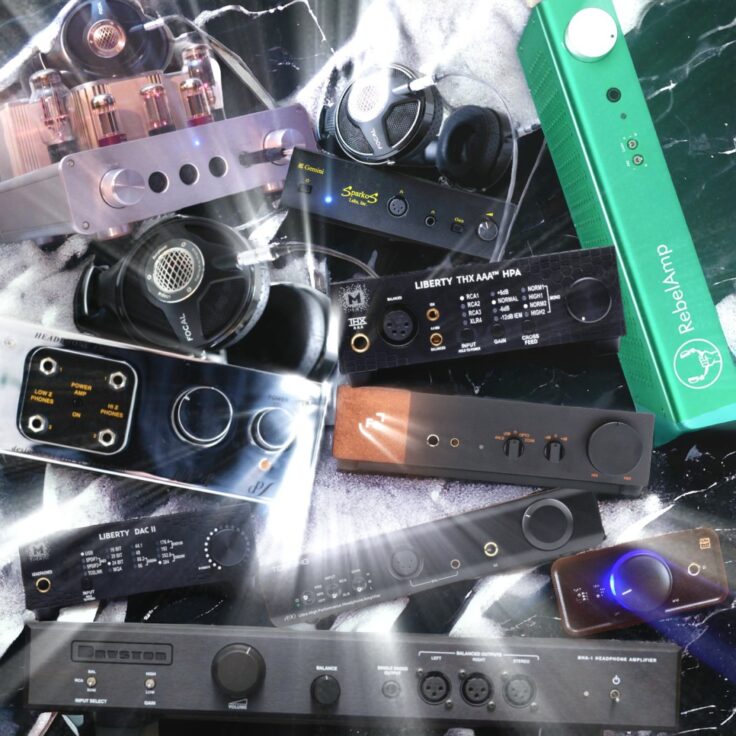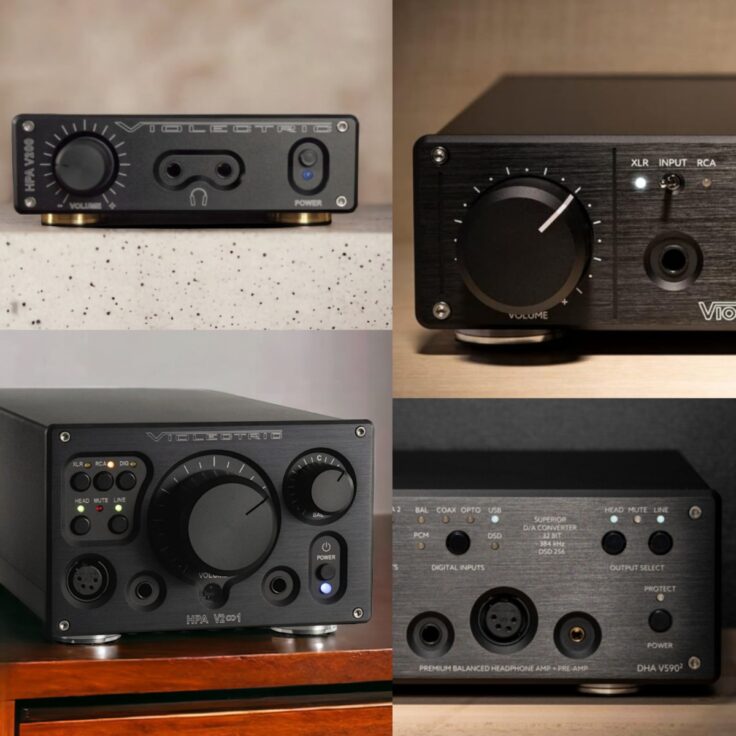The Violectric V281 is the current Violectric flagship amplifier. It is powerful, outputting 4-5 Watts, and can be customized to include an on-board DAC and a remote control. Violectric is a hi-fi friendly sub-brand to the German Lake People Electronic GmbH, a maker of professional grade audio gear.
I have always liked Violectric products because of their quality, no-nonse approach and compact design. I am especially fond of their very versatile and widely acknowledged V200 amplifier. I remember having an email exchange with Fried at Lake People a couple of years ago about the V200, and he happened to share that they were working on a “bigger” V200. He was very enthusiastic. And sure enough, a few months later, the pinnacle of Violectric amplifiers to date was launched, the fully balanced V281. It is an impressive amp. Basically it is an upgraded, doubled up V200. You basically need two amplifiers circuits to make an amp balanced, so they put two V200s in a big chassis, added a bigger power supply, added inputs and outputs and made various tweaks and upgrades. Considering how well the V200 performs, I really looked forward to finally giving this amp some serious listening. And I wasn’t disappointed.
In the following I will run my usual side-by-side/track-by-track comparisons with the relevant amplifiers I had available, using a variety of headphones. I’ll make summaries about each amplifier comparison, and a main conclusion at the end.
Violectric V281 vs Woo WA22
Sennheiser HD800
Spectral Split – Pantha Du Prince & The Bell Laboratory: This is an instrumental tune, a heavy bass line with lots of bell sounds, often coming from the interesting instrument called an aluphone. Both amplifiers sound really nice, great bass, great bell sounds. The V281 is more relaxed in a way, at the same time it feels ultra-precise. The WA22 is a bit fuller sounding, more up front, but not really at the cost of perceived precision. Hard to pick a winner.
Midnight City – M83: Both amps sound terribly good. The difference is that the V281 again has this little extra sense of ease. It’s not that it feels lazy or laid back, just totally in control. The WA22 is very close, but it doesn’t handle the busy parts as elegant and with the same superb separation and control as the Violectric.
It Should Be Obvious – Jørn Øien Trio: Really a fun tune. Lots of percussion, but still quite clean soundstage. The WA22 is very fun to listen to. It has lots of meat on the bone, it is really engaging. The V281 is noticeably cleaner. It also feels more polite sounding. But it has all the dynamics needed when called for. The midrange clearly is less forward than with the WA22.
Higdon: Violin Concerto – Fly Forward – Hilary Hahn: Again, the WA22 is a bit fuller sounding. But this time I find it subjectively as clean sounding as the Violectric. So basically I enjoyed the WA22 a tiny bit more.
Hifiman HE-1000
Maple Noise – Green Serene & Per Jørgensen: Oh boy, this track sounds so alive on the WA22. Extremely spacious, punchy and with a clear, dynamic and organic sounding trumpet in the center of all the percussion. Moving to the V281, I somehow feel part of the magic is lost. There is nothing wrong, it is clean and punchy as always, it just doesn’t have the same “it” factor with this track. Tubes done right with the right music and headphone can be hard to beat, I guess.
Natsukashii – Helge Lien Trio: This is a slow jazz piano piece and turns my preference around. Both are great, but the piano is more delicate and rendered with more nuance and texture with the V281. Percussion is also lighter and more airy sounding. WA22 has a beefier tone, which has attractive qualities too, but I like the Violectric more here.
Midnight City – M83: This track is, for me, one of the more certain ways to separate the V281 from the heap. Certain that the solid-state winner will crush the tube amp on this one, I am a bit baffled that it doesn’t. Yes, the V281 is a bit more neutral sounding, but the WA22 is tight and snappy too, just in a more full-bodied way.
Violin Concerto RV 813 – III – The Young Vivaldi – Ensemble Modo Antiquo: The violins have more flesh with the WA22, more definition and texture with the V281. Both are very engaging, spacious and nuanced.
Overgrown – James Blake: Here, there is a significant difference. The V281 gives me a wide-open room, the WA22 is much more intimate. The Violectric renders “all the room”, like adding a bit of reverb, or rather the WA22 is brushing in too wide strokes. Mostly it is the vocals, James Blake’s voice has more reverb with the V281, I believe that is a result of the generally fatter midrange of the WA22.
Conclusion – Violectric V281 vs Woo WA22
The V281 is superbly balanced, and sounds like it measures beautifully perfect. It’s clean as a lab. Totally awesome. The WA22 is very close in detail and precision, but not all the way there. What it offers instead is a more forward presentation. The midrange is more up front, and instruments feel a bit thicker. Often I find it more engaging. Both have great dynamics. I find it hard to proclaim a clear winner. Which I prefer depends on the music, especially with the HD800. For the HE1000 I think I end up preferring the WA22 overall, it is more fun. But the V281 feels like the technically superior of the two. I guess it’s a matter of taste. The V281 is really impressive, and with busy music it is unbeatable.
V281 vs Auralic Taurus mk2
Hifiman HE-1000
Holberg Suite, Op. 40; V Rigaudon – 1B1 & Jan Bjøranger: Both are great here. Super nice balanced sound, great sustain. Strings have a nice amount of attack. I don’t know if I can say one is better. Both are neutral sounding. Very similar. I have the impression that the V281 is a tad more revealing, but I am not completely certain.
Mi Declaracion – Vinicius Cantuaria: The massive bass in the opening rumbles very nicely on the Taurus. Guitar strings are crisp and clear, percussion precise, vocals nice and warm with lots of texture. Moving to the V281, separation gets even better, the gentle percussion is even more precisely pinpointed in the three-dimensional sound stage. The background is even better. What you lose, however, is some of the warmth in the midrange, noticeable in the male vocals.
Ragged Wood – Fleet Foxes: Lots of people singing, guitars playing and people drumming simultaneously in this song. Though apparently very similar at first listen, when you really listen into the music the V281 is clearly more comfortable with the complexity. In its usual understated way, it handles all the fuzz with ease, making it easier to follow each instrument and voice.
Never Forget the Good Ones – Solveig Slettahjell: Slow, quiet, female jazz vocals with a sore trumpet and an old piano. In the opening, the singer’s voice is a bit fuller bodied with the Taurus. The following trumpet as well. But the V281 compensates for its politer midrange with extra subtlety and texture.
Sennheiser HD800
Lost Highway – Bill Frisell: I love the sound of the electric guitar on this one. The Taurus renders it in a nice and warm way, the soundstage is spacious and the bass is generous. The V281 presents a tighter but also less full-bodied soundstage. It feels more precise, but a bit less playful.
Mi Declaracion – Vinicius Cantuaria: The depth of the soundstage is insane on the V281. The background is dead silent, the separation is truly stunning. Everything is delicate and controlled. The bass is plentiful, yet full of texture. Moving on to the Taurus, you lose a little bit of that detail, but things come to life in a different way, vocals are a bit more up front. Somehow the Taurus gets my toe tapping, whilst the V281 fills me with awe.
Winter, Vivaldi 4 Seasons – The Norwegian Chamber Orchestra: The V281 is hyper detailed as always, which is easy to appreciate, but I feel the violins sounds a tad more natural with the Taurus.
Martinů: Three Madrigals For Violin And Viola Op.H 313 – I. Poco allegro – Emerson String Quartet: Another string-piece, I start with the Taurus, and I am fascinated with the ability to pinpoint each instrument in three dimensions. Texture is great, you can feel the bows friction against the strings. This time I feel the strings are maybe a bit more natural when I switch to the V281. Maybe. Switching back and forth makes me very uncertain which to prefer, they are quite similar. And extremely good.
Mahler Symphony No.2 – III – Paavo Järvi/hr-Sinfonieorchester: This symphony contains a lot of dynamic contrasts. The massive kettle drums in the opening is soon relieved by gentle violins and a slow build-up for another crescendo. Although both do very well, I feel the V281 handles especially the minor nuances of the low volumes better.
Plane Temp – Glasser: This song can sound a bit forced, strained and unpleasant. The Taurus/HD800 certainly isn’t the best way I have heard this. Going to the V281 does indeed make it nicer, with its controlled, unstrained presentation. Again, the V281 proves its strength when things get complicated.
Audeze LCD-X
Overgrown – James Blake: I love the LCD-X on these amps, but there isn’t really too much to write about how different they sound on this track. Both presents a warm, full bodied sound, vocals and bass line alike. Only difference I find is that the bass seems a bit more prominent with the V281.
Ragged Wood – Fleet Foxes: On this busy track of singing, guitar playing and various percussion, the V281 shows its superiority in terms of separation. At first listen, they are very close, but it is easier to separate elements with the V281. Not that the Taurus is bad, far from it, it is almost there too.
Mozart: Violin Concerto No.5 In A, K.219 / Vieuxtemps: Violin Concerto No.4 In D Minor, Op.31 – 2 – Hilary Hahn: In the intro with the solo violin, they have a slightly different sound signature to the strings, but cannot really say I prefer one over the other. As things get busier I tend to favor the V281, because it simply gives a bit more room for each instrument and makes it easier to separate them. Otherwise they are quite similar.
Conclusion – V281 vs Auralic Taurus mk2
These are both high end amplifiers. They are very, very close and strive towards neutrality and perfection. But the differences are audible and consistent. With the HE-1000, the Taurus gives a bit more weight to the midrange, which adds some extra body to voices and typical midrange instruments. The V281 is a bit polite, but in a very pleasant way, and with its superb control and separation it is hard to beat. Especially in busy music, it is massively impressive.
The Auralic Taurus is also a very good amplifier for the HD800. But the V281 is better. The difference isn’t always obvious, but when things get busy, you can always trust the Violectric to have total control.
As with the other headphones I have tried with these two amplifiers, the difference with the LCD-X boils down to the Taurus being more up front in the midrange, in a positive way, whilst the V281 boasts better separation. Sometimes it is hard to really identify differences, but when things get busy the V281 never fails to impress.
V281 vs EAR HP4
Unfortunately, I didn’t have the time to compare the V281 to the EAR HP4 with more than the HD800, but I really hope to elaborate in the future.
Sennheiser HD800
Bergen Open – BMX: The V281 is truly great on this mostly toned down improvised jazz piece. Truly exceptional. The timing, precision, tone, texture… The detail level is insane. Pure bliss. Moving to the HP4 there is a change in tonality, or in something. But it too has superb timing, precision, tone, texture… and the level of detail is still insane. It is like two different versions of perfection. But there is something extra to the HP4. Some additional natural flowing character.
Summer – III Presto – Vivaldi 4 Seasons – The Norwegian Chamber Orchestra: The HP4 sounds truly great, but moving over to the V281, it becomes clear that the Violectric has a small edge on separation. On complex music like this, it seems the Violectric puts most amps to shame, although I don’t want to use that word here. The HP4 is still really, really, really good and almost on par with the V281 at its strongest point. In addition, it has that extra smooth flow. They are the stereotypes of solid state perfection vs the perfect tube amplifier. They both give what feels like near perfect output, but they have different characters.
Conclusion – V281 vs EAR HP4
I continued to listen to various music, and my impression remained pretty consistent: The Violectric V281 makes the HD800 sound like a high-end studio monitor setup. The HP4 makes the HD800 sound like a high-end tube stereo system. Your choice.
V281 vs Burson Conductor V2
Hifiman HE-1000
Europe Is Lost – Kate Tempest: Great bass loop on this song. It is clearly tighter and better textured with the V281. The Conductor is absolutely ok, but the Violectric proves you get something more for paying more than twice as much. Vocals are crisper, background is blacker, staging more precise.
Fountain Stairs – Deerhunter: Basically, the Conductor is softer, less defined.
Monument – Röyksopp: Again, V281 clearer and tighter. But the tonality is very similar and frankly I am impressed with the Conductor for keeping up as good as it does.
Other Headphones
I also did a brief comparison between the Conductor V2 and the V281 with the Audeze LCD-3, the Sennheiser HD800 and the Oppo PM1. With all of them the Violectric was a bit tighter and clearer across the range, but the tonality was very similar. I was frankly very impressed with the Conductor because it was so close to the V281, which is so much more expensive and has proven to be a very solid performer with every headphone I have tried. But still, the Conductor is consistently a bit more diffuse. It drives the headphones very well- it’s just that the V281 is always better.
Violectric V281 vs V200
This comparison is especially interesting, since the V281, as mentioned, builds on the V200, mostly by doubling up on amplifier modules in order to make it balanced. So the V200 is both a predecessor and a baby brother.
Audeze LCD-3
Playing Vincente Amigo’s “Cuidad De Las Ideas” album on my LCD-3 (original version), I struggle a bit to find significant differences between the Violectric siblings. Moving on to Tomaz Stanko’s “Terminal 7”, they still sound a lot alike, but the V281 always feels a tad clearer. The same with M83’s “Midnight City”. With Hilary Hahn playing her energetic violin in “Fly Forward” I still often struggle to separate the two amps when going back and forth.
Hifiman HE-1000
Playing some more Hilary Hahn, now with the HE-1000, there is a bit more difference. Strings and wind instruments have more bite with the V281, sounds are more distinct. But still these amps are clearly very similar.
MIA’s World Town reveals slightly tighter bass and a crisper presentation by the bigger brother. But not by much.
Lazarus – David Bowie: Going from the V200 to the V281, l immediately notice that the bass becomes tighter and more pronounced. Bowie’s vocals are more open sounding too, things are generally a bit crisper.
Journeys – Emerson String Quartet: All through the string Quartet album it is obvious that the bigger brother is better. Strings are clear and crisp with that little extra bite, not due to distortion but because of increased clarity.
Third of May – Fleet Foxes: I get the same result. With complex music, the extra clarity of the V281 is audible.
Remarks: With the HE1000 I set the V200 at +6 gain
Sennheiser HD800
Playing a range of tracks, it seems hard to find anything noteworthy between the two siblings. The V281 might have a tad better definition, but differences are mostly just subtly present. But finally I find some differences:
This Love is Here to Stay – Thomas Dybdahl: This is one of the tracks that make it easier to separate the two. There’s better separation between instruments with the V281. Thomas’ voice sounds more textured, crisper.
Running to The Sea – Röyksopp: Here too, the vocals are rendered with more nuance and texture with the V281. The V200 is slightly more diffuse in a general way all along the spectrum. Just slight, but audible.
Midnight City – M83: The Violectric V281 is a tad better here too. They are annoyingly close sound-signature wise, what separates them is that the V281 always seems a bit tidier.
With the HD800, both the Violectric amps are superb. The V281 is basically a better V200, and that is what it sounds like. The HD800, being HD800 – with its pronounced high end, compensates for the V200’s slightly shy treble, making the difference between the amps appear very small in direct comparison, but still significant. It is worth to mention that when I compared the V281 and the V200 to other amps in my big HD800 comparison review, the V281 was notoriously better, whilst the V200 was great, but not always better.
Fostex TH-900
After a series of coherent findings, where the bigger Violectric always is similar but consistently preferred, I am I bit surprised about how the TH900 turns out. It seems the V200 gives me a warmer and fuller sound, without any audible loss of detail. The V281 comes off a bit thinner sounding without giving me anything to compensate. With Fleet Foxes latest album and Bill Frisell’s ”We are Saying” and Vicente Amigo’s “Compare Manuel”, I always prefer the V200 for its midrange warmth and full-bodied sound.
After further listening, I ended up concluding that the V281 is a bit more detailed, but that I consistently prefer the V200 for what I hear as more midrange warmth. With most cans, the V281 just feels like a more detailed V200. But maybe it has something to do with the V200 being slightly more laid back in the higher registers, and that the TH900 can be a bit bright and bassy.
Remarks: I used the unbalanced output of the V281 for the TH900.
Beyerdynamic T1
Garari – Helge Lien Trio: With the treble heavy T1 (original version) I experience the same as with the TH900. The slightly muted treble of the V200 seems to give a nicer tonal balance, compensating for the slight loss of detail.
Life Round Here – James Blake: Same here. The bright electronic percussion and crisp sounding vocals sound slightly less overly bright with the V200.
Oppo PM1
The Oppo PM1 is not bright at all – rather the opposite. So it came as no surprise that things turned back to normal:
Yesterdays – Olga Konkova: Moving over to the PM1, the V281 again is preferred for its crisper piano, blacker background and generally tighter tightness.
Gorogoro – Helge Lien Trio: Also here, the V281 especially shines in the treble region, which sometimes is a bit too toned down with the V200.
Conclusion – Violectric V281 vs V200
The V281 took all the strengths from the V200 and fixed its weaknesses. The V200 sometimes can get a bit “dark”, making the upper end a bit lame. The V281 adds some extra control and detail and slight upper end intensity and tightens up the bass quite a bit, but keeps the main sound signature. If you like the V200, you will love the V281. If you didn’t like the V200, you’ll like the V281.
Remarks: Source Master 7, XLR to V281, RCA to V200.
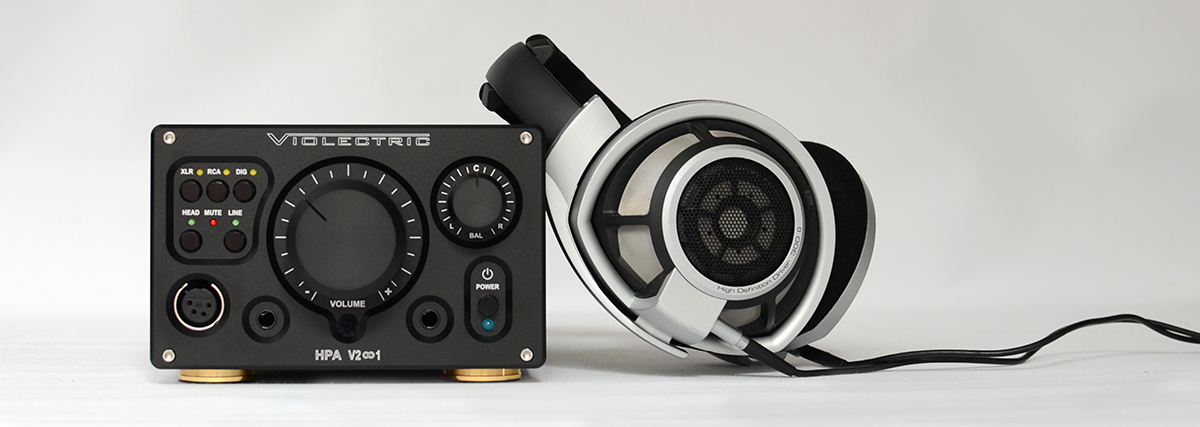
V281 vs Audio-gd Master 9
The V281 is a beast. But it is small compared to the Master 9. Both are powerful, “no compromise” balanced amplifiers.
Sennheiser HD800
I initially struggle a bit to find real things to report about differing performance, but finally I find a track that makes the difference clearer:
Violin Concerto in D Minor, RV 813 III. Allegro Adagio – Ensemble Modo Antiquo: This very lively string piece reveals the Master 9 as a bit meatier, with more flesh to the strings. The V281 is a tad sharper.
Viaticum (1) – EST: This track has me struggling again. Whenever I feel like concluding that the V281 is more detailed, I tend to think “hmm, maybenot” when swapping back to the Master 9.
Midnight City – M83: This track never fails me. It reveals an amplifier’s ability to keep stuff tidy. And the V281 is better at it than the Master 9.
Merciful – Nils Petter Molvær: Simple song with vocals and a piano. V281 feels ever so slightly cleaner. But just a tad.
Hifiman HE-1000
Again, I end up playing several tracks before I can get anything more than a slight feeling of a significant difference between these two great amplifiers. But it feels like the Violectric is a tiny tad sharper.
Dualist – Ola Kvernberg: Especially the percussion feels a bit crisper with the V281. The bass drum a bit harder hitting too.
Violin Concerto in D Minor, RV 813 – III. Allegro – Adagio – The Young Vivaldi – Ensemble Modo Antiquo: As with the HD800 I find the Master 9 to be fleshier and meatier sounding with the strings. The Violectric is sharper, and presents each instrument as sounding a bit thinner but more textured in a way I prefer. It is not obvious that everybody would have the same preference as me, though. The Master 9 has a very appealing sound signature that feels more relaxed yet still full of timbre. The V281 is a bit more aggressive sounding.
Audeze LCD-X
Muggen fallskjerm – Jøkleba: The V281 is slightly snappier with this percussion driven jazz piece. Again the Master 9 is slightly softer. Not veiled or diffuse, but slightly rounder edges.
Almost Like the Blues – Leonard Cohen: Cohen’s voice is definitely fuller with the Master 9. The V281 feels more correct, however. I am surprised by how much difference I suddenly hear, given my problems with identifying differences between them before.
As Before – Olga Konkova: Again the vocals, this time a tender female voice, feels a bit thicker and fuller with the Master 9, but not as much as with the Leonard Cohen track. Otherwise they are not that different. The V281 is a tiny bit more open and clean sounding.
This Love is Here to Stay – Thomas Dybdahl: Same thing here.
I go back to the HD800 and find the same, that the Master 9 is making the voice a bit fatter, but to a less lesser extent with the HD800 than with the more midrange centric LCD-X. I also try the Shure SRH1840 (balanced cable). There is a different voicing when I compare the two amps. The Master 9 is a tad fuller and softer sounding.
Conclusion – V281 vs Audio-gd Master 9
With the HD800, the Master 9 and V281 sound very close in most cases, and share a similar “neutral but slightly darkish” sound signature. But when things get busy, the V281 puts its head first.
With the HE-1000, the two amps are really similar, but where there are clear differences, the V281 sounds crisper and tighter, whilst the Master 9 has a more relaxed and slightly meatier sound signature. I find the same with the LCD-X and SRH-1840, but to higher extent.
Hifiman HE-6
The discontinued Hifiman HE-6 is a somewhat special case in the headphone world, because it is so insensitive that it is widely regarded as best driven with a speaker amplifier (from the speaker taps). Few headphone amplifiers manage to bring the HE-6 close to its full potential. It is rated at a sensitivity of 83,5 dB. The recently released successor to the HE-6, the Hifiman Susvara is rated at 83 dB. I compared the V281 to some of the few headphone amplifiers that actually can make the HE-6 sing, and a good 80 wpc stereo amplifier.
V281 vs Auralic Taurus
Compare Manuel – Vicente Amigo: The V281 is super tight with great precision. The guitar is fabulously positioned in an exact point in space. Moving to the Taurus, things get a little less distinct, but significantly warmer in a welcoming way. With this track, I find the V281 to be overly analytical with the HE-6. The V281 feels powerful as anything, I ran it at +6 and pre-gain, volume knob at 10 o’clock. With the +12 gain the volume knob was at 8. Taurus doesn’t have pre-gain switches, but volume wheel is at 10.
Dualist – Ola Kvernberg: This is a crowded track. Suddenly the analytical abilities of the V281 is not a disadvantage at all, it just makes everything super clear and all instruments easily separable. With the Taurus it’s a bit more blended together. It still sounds very good, but the V281 just steals the show with its excellent control.
As Before – Olga Konkova: The ultra-precision of the V281 is simply amazing. Everything is stitched up on an imaginary wall at a specific point. Or rather, it’s not a wall, it’s a point in space; the soundstage is very three dimensional. The Taurus fleshes things out a bit. By itself it sounds great and tight, but in direct comparison, there’s no question whatsoever who is the “king of control”.
Scheherazade 2: III. John Adams – Leila Josefowic: Again, the V281 is brilliant and ultra clear. The various elements on this modernist piece is crisp, distinct, with lots of blackness to the background. The Taurus sounds really good, but once again, it cannot compete in direct comparison.
V281 vs Master 9
Mi Declaracion – Vinicius Cantuaria: V281 sounds really nice with a warm presentation, deep and tight bass, and a spacious feeling. Master 9 is quite similar, actually, but it is less crisp and slightly warmer – in a nice way. The Master 9 feels a bit softer and less crisp, I do not agree with myself whether it is a good or a “bad” thing, so I guess they are just on the same level subjectively. Still I feel that the Violectric has the edge as the most technically precise performer.
Ragged Wood – Fleet Foxes: Again the two amps sound quite similar, but the V281 feels a bit more tight and precise with a more defined and less bold midrange.
Dualist – Ola Kvernberg: In the beginning of the track, with lots of bass, drums, strings and other stuff going on, the V281 is tidier and better defined. The Master 9 is not bad, but not at the same level. The V281 has more control.
Remarks: Source Audio-gd Master 7 – RCA to V281, XLR to Master 9
V281 vs Creek Loudspeaker Amplifier
Comparing the V281 to my Creek 5350SE, directly to the speaker taps, the V281 gets some real competition.
Kvernberg, Cohen Nevermind: V281 is a tad more polite, giving the impression of being more subtle, but I’m not sure. They are on the same level in many ways, but the Creek is maybe a bit more dynamic. The V281 might have better bass texture. They are definitely not identical, but I find it hard to declare a clear preference with tthis song
Three Madrigals for Violin and Viola Op.H 313 – Martinů – Emerson String Quartet: They are still similar, but maybe the V281 is a bit more textured. A bit less up front, maybe.
Compare Manuel – Vicente Amigo: The Creek again feels a bit more up front. A bit more alive, without losing any real sense of detail, but maybe a tiny bit less of that fine nuance.
Pledge For Peace – Chick Corea: Swapping back and forth, I cannot conclude much other than that the Violectric drives that HE6 just as good as the Creek. Maybe even better. A little less bold, a little more nuance. But that’s more of a sound signature thing. The V281 feels a bit more airy sometimes.
Remarks: Source Audio-gd Master 7 – RCA to Creek, XLR to V281
Violectric V281 vs Violectric V200
The V200 isn’t really quite up to the task, but I found it interesting to check it out nonetheless. First, given my low expectations, I was really impressed with the V200, with the gain switch at +12dB it sounds very nice at first. Still it is no match for the V281. The V200 does a good job – the HE-6 isn’t wasted on it. It just sounds very much more like itself on the V281.
Conclusion – Hifiman HE-6
The Violectric V281 drives the HE-6 much better than the V200, better than the Auralic Taurus slightly better than the Audio-gd Master 9 and possibly better than or equal to my 80 Wpc Creek 5350SE speaker amp. But the Creek speaker amp and the V281 areso close I wouldn’t consider getting the V281 for the HE-6 if I already had the Creek, and vice versa.
Main Conclusion
The Violectric V281 is the type of amplifier that makes you feel that the only thing you can hold against it is that it is “too good”. By this I mean that some might find it “too” clean and neutral, in the same way as people can find a room “too tidy to feel cozy”, or that “flawsless music” can feel soulless. When I prefer other amplifiers, it is because they add something. A small mid-bass bump, a bit fleshier midrange, a bit more “zing” to the treble. Sometimes we refer to amplifiers that are distorting the sound in a pleasurable way as “musical”. And that is totally ok. But it does not make clean audio unmusical. The V281 sounds neither cold nor clinical. It is pure, powerful and full of insight. But sometimes other amps are a bit more fun. Less well behaved, so to speak. And it all depends on the recording and the headphones.
The V281 is so clean, powerful and silent that it flawlessly drives any headphone I have tried. Lots of amplifiers are claimed to be able to “drive anything”, but there’s usually exceptions. Sometimes it is not powerful enough, sometimes, it is too noisy with sensitive cans, sometimes it’s a bad match with specific headphones. The V281 can run my Monk earbuds as quietly as it runs my Hifiman HE-6 powerfully. To sum it up: If the V281 ever does anything wrong – I haven’t heard it yet.
The review unit was kindly lent to The Headphoneer for the prupose of this review by Duet Audio
Manufacturers Specifications
Source: Lake-People
All Measurements RMS unwtd., 20 Hz – 20 kHz, Pre-Gain set to 0 dB
Inputs:
2 x XLR female, balanced
2 x RCA, unbalanced
1 x digital (Option)
Max. input voltage: + 21 dBu
Input impedance: 10 kohms
Line outputs:
2 x XLR male, balanced
2 x RCA unbalanced
Nominal input sensitivity: +6 dBu
Amplifier gain: +8 dB unbal. / 14 dB bal.
PRE-GAIN: -12 / -6 / 0 / +6 / +12 dB
Frequency range: 5 Hz … 70 kHz (- 0.5 dB)
3 Hz … 200 kHz (-3 dB)
Output impedance: < 0.1 Ohm unbal. / < 0.2 Ohm bal.
Damping factor (Load 50 Ohm): 500 unbal. / 250 bal.
Dynamic range: > 129 dB (A-wtd)
Noise: < -95 dBu (A-wtd)
THD+N (1kHz/2x10V/100R = 1W) < -102 dB / < 0,00079 %
THD+N (1kHz/2x4V/32R = 0,5W) < -100 dB / < 0.001 %
Crosstalk: -105 dB (1 kHz) / -103 dB (15 kHz)
Headphone outputs: 1 x 4-pol XLR
2 x 1/4“ (6.3 mm) Phone Jack
Max. output level (1kHz / < 0.1% THD+N) Balanced operation Both channels driven
RL (x2) / Ua(dBu) / Ua (V) / Pa (mw)
600 Ω 34,3 / 40,2 / 2700
100 Ω 29,7 / 23,7 / 5600
50 Ω 25,4 / 14,5 / 4200
32 Ω 21,7 / 9,5 / 2800
16 Ω 16,0 / 4,9 / 1500
Power supply: 230 V AC / 115 VAC max. 40 VA
Case, Front, Back: Aluminum
Dimensions: 170 x 112 x 320 mm (B x H x D)


